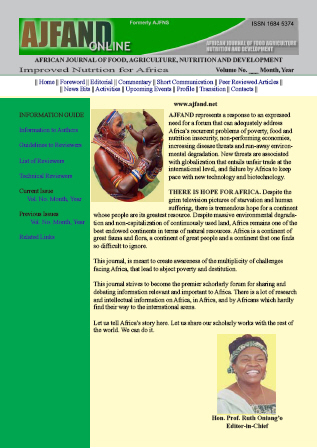
|
African Journal of Food, Agriculture, Nutrition and Development
Rural Outreach Program
ISSN: 1684-5358
EISSN: 1684-5358
Vol. 19, No. 3, 2019, pp. 14654-14673
|
 Bioline Code: nd19049
Bioline Code: nd19049
Full paper language: English
Document type: Research Article
Document available free of charge
|
|
|
African Journal of Food, Agriculture, Nutrition and Development, Vol. 19, No. 3, 2019, pp. 14654-14673
| en |
THE NUTRIENT CONTENT OF TWO FOLIA MORPHOTYPES OF CENTELLA ASIATICA  (L) GROWN IN MADAGASCAR (L) GROWN IN MADAGASCAR
Ranovona, Z; Mertz, C; Dhuique-Mayer, C; Servent, A; Dornier, M; Danthu, P & Ralison, C
Abstract
Centella asiatica is a herbal plant generally used for its curative properties. Two foliar
morphotypes were recently identified in Madagascar: a reniform tetraploid (2n = 4x =
36) in the Center and the East of the island and a round diploid (2n = 2x = 18) in the
West. The objective of this study was to evaluate the nutritional properties of these two
morphotypes and to compare them with other green leafy vegetables. Reniform leaves
were collected in Antananarivo and Moramanga and round leaves were collected in
Tsiroanomandidy and Analavory. Macronutrient content was determined by standard
methods, mineral contents were analysed by inductively coupled plasma atomic emission
spectroscopy. Ascorbic acid and carotenoids were quantified by HPLC. Food
composition showed significant differences between the morphotypes. Reniform leaves
have higher protein content (19–22 % dry weight (DW)) than round leaves (17–21 %
DW). Lipid content are from 2.5 to 6.0 % DW. Reniform leaves have higher iron content
than round leaves. Iron content of C. asiatica’s leaves range from 3.8 to 12.5 mg/100 g
fresh weight (FW). Reniform leaves from Moramanga have the highest protein, lipid and
iron content. Round leaves from Analavory have the highest calcium and magnesium
content, which can cover 41 % and 17 % of the Recommended Dietary Allowances
(RDA), respectively. Leaves of C. asiatica have low vitamin C content (1.3 to 7.7
mg/100 g FW). Consumption of 100 g of C. asiatica leaves could cover 10 to 21 % of
vitamin A daily requirements of women for reniform leaves and 21 to 37 % of vitamin
A requirement of women for round leaves. Round leaves from Analavory have the
highest β-carotene content. It is hoped that from these findings, the people of Madagascar
will be encouraged to include C. asiatica in their diets for its nutritional benefits.
Keywords
Centella asiatica; reniform leaves; round leaves; protein; lipid; vitamin A; minerals; amino acids
|
| |
© Copyright 2019 - African Journal of Food, Agriculture, Nutrition and Development
Alternative site location: http://www.ajfand.net/
|
|
